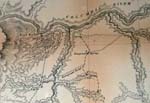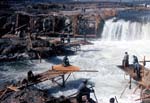 | | The 1860 Joseph Dixon map |
While the written history
of this region often begins with the arrival of Lewis and Clark in 1805, the Warm Springs, Wasco and Paiute people have each had a long and significant history dating back centuries. We often begin the chronology of our history with Coyote and the other Animal Peoples who prepared the world for the coming of human peoples. See Our Origins.
|
|
Margaret Suppah discusses how her "grandma" used to wonder what the white people were, having "crawled out of the ocean," with "different colored eyes." (Interviewed by Duran Bobb. October 2002) |
On three pages of this U.S. section of the Warm Springs module we will consider some of the important historical events resulting from contact with White “civilization” and the often catastrophic effects of those events on our way of life. As Arlita Rhoan considers below, it is a history, even when unpleasant, that is essential for all of us to remember for its various legacies continue to influence us today.
|
|
Garland Brunoe talks about the prophecy of a medicine man concerning the coming of whitemen to Wasco country and the consequences of their arrival. The vision was received along before contact. To read a detailed account of the vision, go to Prophecy. (Interviewed by Brigette Whipple, October 2003) |
In 1821, the Hudson's Bay Company established Fort Vancouver downriver from our Wasco and Warm Springs villages. Until 1831 the fur brigades traveled the John Day River basin. Soon after, in 1838, Henry Perkins built Wascopam, a Methodist mission, at The Dalles and began "preaching" amongst us. The "rivial" that followed was called by the Wasco and Warm Springs converts as the "Wonderful Work of God." But in comparison with other tribes, the long-term effects of the fur trade and of the missionary on the Wasco and Warm Springs families was not as significant. The Wasco and Warm Springs families seldom experienced the “heavy-handed” conversion of entire families, and much of the conflict between families that followed, known so well by our neighbors upriver, the Nez Perce and Coeur d’Alene.
|
|
Myrna Frank considers the original hospitality offered to whites, but how soon after, abuses of that hospitality led to being more suspecious of the whites. (Interviewed by Duran Bobb. October 2002) |
|
|
Jacob Frank talks about and compares Indian and "white man's" foods brought by the early immigrants, and how the white man became a "brother to the cow." (Interviewed by F. Duran Bobb and Tim Finch, December 2002) |
As the Columbia River itself was a natural "highway," more and more white immigrants passed by our villages on their way west, many initially settling in the Willamette Valley to the west of us. By 1852, over 12,000 settlers were crossing through our country each year, with each influx of immigrants, more and more were staying on our traditional lands.
|
|
Arlita Rhoan, Warm Springs elder, talks about the importance of remembering "history," even when it is unpleasant. (Interviewed by Brigette Whipple and F. Duran Bobb, October 23, 2002) |
 | | Celilo Falls, ca. 1956 |
Even before the onset of these newcomers and continuing after their arrival, a series of contagious disease epidemics ravaged our villages. Lacking any immunity to these diseases, smallpox and the other afflictions decimated our families and villages, especially among the young and the elderly, the weakest and most susceptible. It is estimated that almost half our populations had already been infected and killed by the time Lewis and Clark arrived amongst us in 1805.
|
|
James Noteboom, Tribal Attorney, talks about the diseases that had ravaged the Indian communities and were observed by Lewis and Clark. (Interviewed by Brigette Whipple, June 2003) |
© Confederated Tribes of Warm Springs 2003
< previous | next >
|



